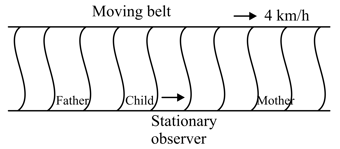Two bodies A and B are 10 km apart such that B is to the south of A. A and B start moving with the same speed 20 km/hr eastward and northward respectively then find. N

(a) relative velocity of A w.r.t. B. W/ E
(b) minimum separation attained during motion
(c) time elapsed from starting, to attain minimum separation.

(a) relative velocity of A w.r.t. B. W/ E
(b) minimum separation attained during motion
(c) time elapsed from starting, to attain minimum separation.

Important Questions on Kinematics
A body is projected with velocity from point as shown in the figure. At the same time, another body is projected vertically upwards with a velocity from point . What should be the value of for both bodies to collide?

A child runs to and fro with a speed (with respect to the belt) on a long horizontally moving belt (figure) between is father and mother located apart on the moving belt. The belt moves with a speed of . For an observer on the stationary platform outside, what is the speed of the child running in the direction of motion of the belt and speed of the child running opposite to the direction of motion of the belt? time taken by the child in and . Which of the answers will alter if motion is viewed by one of the parents?

